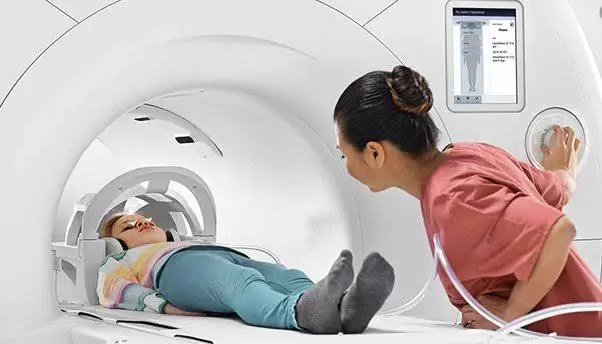Why are no metallic items allowed to be worn inside an MRI room?
An arm MRI (magnetic resonance imaging) scan uses strong magnets to create pictures of the upper and lower arm. This may include the elbow, wrist, hands, fingers, and the surrounding muscles and other tissues.
For the MRI exam, the patient is placed inside of the MR system or scanner—typically a large donut-shaped device that is open on both ends. The powerful magnetic field aligns atomic particles called protons that exist in body tissues that contain water. The applied radio waves then interact with these protons to produce signals that are picked up by a receiver within the MR scanner. The signals are specially characterized using the rapidly changing magnetic fields. With the help of computer processing, cross-sectional images of tissues are created as “slices” that can be viewed in any orientation.
As a patient, it is vital that you remove all metallic belongings in advance of an MRI examination, including external hearing aids, watches, jewelry, cell phones, and items of clothing that have metallic threads or fasteners. Additionally, makeup, nail polish, or other cosmetics that may contain metallic particles should be removed if applied to the area of the body undergoing the MRI examination.
The powerful magnetic field of the MR system will pull on any ferromagnetic object in or on the patient’s body such as a medical implant (e.g., certain aneurysm clips, medication pumps, etc.). Therefore, all MRI facilities have comprehensive screening procedures and protocols they use to identify any potential hazards. When carefully followed, these steps ensure that the MRI technologist and radiologist know about the presence of any metallic objects so they can take precautions as needed.
एमआरआई कक्ष के अंदर किसी भी धातु की वस्तु को पहनने की अनुमति क्यों नहीं है?
एक बांह एमआरआई (चुंबकीय अनुनाद इमेजिंग) स्कैन ऊपरी और निचली बांह की तस्वीरें बनाने के लिए मजबूत चुंबक का उपयोग करता है। इसमें कोहनी, कलाई, हाथ, उंगलियां और आसपास की मांसपेशियां और अन्य ऊतक शामिल हो सकते हैं।
एमआरआई परीक्षा के लिए, रोगी को एमआर सिस्टम या स्कैनर के अंदर रखा जाता है – आमतौर पर एक बड़ा डोनट-आकार का उपकरण जो दोनों सिरों पर खुला होता है। शक्तिशाली चुंबकीय क्षेत्र प्रोटॉन नामक परमाणु कणों को संरेखित करता है जो शरीर के ऊतकों में मौजूद होते हैं जिनमें पानी होता है। फिर लागू रेडियो तरंगें इन प्रोटॉन के साथ संपर्क करके सिग्नल उत्पन्न करती हैं जिन्हें एमआर स्कैनर के भीतर एक रिसीवर द्वारा उठाया जाता है। सिग्नलों को विशेष रूप से तेजी से बदलते चुंबकीय क्षेत्रों का उपयोग करके चित्रित किया जाता है। कंप्यूटर प्रोसेसिंग की मदद से, ऊतकों की क्रॉस-सेक्शनल छवियां “स्लाइस” के रूप में बनाई जाती हैं जिन्हें किसी भी अभिविन्यास में देखा जा सकता है।
एक मरीज के रूप में, यह महत्वपूर्ण है कि आप एमआरआई जांच से पहले सभी धातु के सामान को हटा दें, जिसमें बाहरी श्रवण यंत्र, घड़ियां, गहने, सेल फोन और धातु के धागे या फास्टनरों वाले कपड़ों की वस्तुएं शामिल हैं। इसके अतिरिक्त, मेकअप, नेल पॉलिश, या अन्य सौंदर्य प्रसाधन जिनमें धातु के कण हो सकते हैं, उन्हें एमआरआई परीक्षण से गुजरने वाले शरीर के क्षेत्र पर लगाने पर हटा देना चाहिए।
एमआर प्रणाली का शक्तिशाली चुंबकीय क्षेत्र रोगी के शरीर में या उसके ऊपर किसी भी लौहचुंबकीय वस्तु जैसे कि मेडिकल इम्प्लांट (जैसे, कुछ एन्यूरिज्म क्लिप, दवा पंप, आदि) को खींच लेगा। इसलिए, सभी एमआरआई सुविधाओं में व्यापक स्क्रीनिंग प्रक्रियाएं और प्रोटोकॉल हैं जिनका उपयोग वे किसी भी संभावित खतरे की पहचान करने के लिए करते हैं। जब सावधानी से पालन किया जाता है, तो ये चरण सुनिश्चित करते हैं कि एमआरआई टेक्नोलॉजिस्ट और रेडियोलॉजिस्ट को किसी भी धातु की वस्तु की उपस्थिति के बारे में पता है ताकि वे आवश्यकतानुसार सावधानी बरत सकें।




